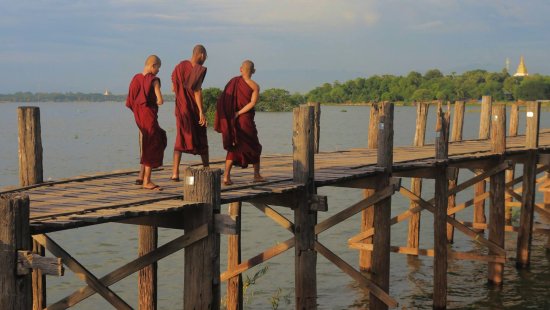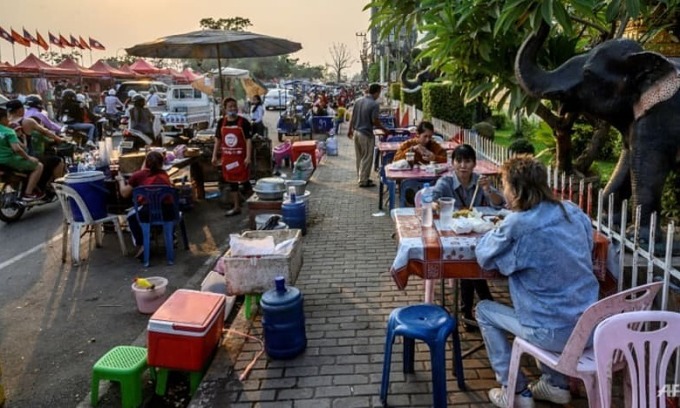Burma tour: a sleeping beauty awakes
Touring Burma’s temples and villages, Teresa Machan finds the country’s inherent charm a big draw for visitors.
As I cycled across the plain of Bagan towards temple number 473, I
was reminded of one of two reasons why, in the past, I had not been
immediately drawn to Burma. Travellers on Asia’s
overland trail call it temple fatigue – when the blur of stupas,
minarets, gold-leafed deities and all manner of reclining, seated, curly
haired and bee-stung-lipped variations on the image of Buddha ceases to
have any impact. I had been afflicted a number of times and Burma, more
so than any other country in the region, is synonymous with temples.
Yet, here I was climbing centuries-old steps by candlelight, catching
my breath at the top and wondering when I’d ever clapped eyes on such a
sunset tableau. As dusk seeped into night only the white stucco temples
were visible, glinting like multiple moons over the vast plain.
Packed with the remnants of its glory days as an ancient capital and
kingdom, Bagan is studded with temples as far as the eye can see (more
than 2,000 remain). The next day at sunrise, after only four hours’
sleep on board the river cruiser Road to Mandalay, I hovered in a
hot-air balloon over a few hundred more before landing in a perfectly
upright basket at the edge of a peanut field.
Marco Polo wrote of “a gilded city, alive with tinkling bells and the
swishing sound of monks’ robes”; from our eyrie a few thousand feet up
the scene – encompassing acres of Bagan’s famed temple footprint – was
no less dramatic. A low-slung wizard’s beard of a mist veiled the
fairy-tale temples until the golden disc rose above the horizon –
lighting up one stupa after another as if part of a choreographed show. I
vowed never again to succumb to temple fatigue.
The 200-year-old teak U Bein bridge, Amarapura
Until recently a visit to Burma was
still seen as fairly remarkable. For decades the country’s military
junta divided travellers into “yes” and “no” camps, keeping all but a
trickle of tourists from its door. But that changed in 2010 following
the release from house arrest of pro-democracy leader Aung San Suu Kyi
and the lifting of the tourism boycott by Suu Kyi’s party, the National
League for Democracy. It wasn’t until seeing an interview with Suu Kyi
at her home in Rangoon, however, that I was convinced.
“Come to Burma with your eyes open,” Suu Kyi had said. “Use your liberty to promote ours.”
The footage was part of the 2011
Brighton Festival that Suu Kyi guest-directed. Over its three-week run I
attended lectures, listened to the harrowing story of Burmese exile
Zoya Phan, spoke to campaigners from Burma UK and made a paper lotus
flower as part of a 2,000-strong installation to represent the 2,100
political prisoners languishing in Burmese jails. When the opportunity
came to sail along the Irrawaddy two months later, I accepted.
Straddling five international borders
including China in the north and Thailand in the south, kite-shaped
Burma is as topographically and ethnically diverse as it is large. Most
escorted tours will take in Rangoon, Bagan and the stilt-house villages
and floating gardens of Inle Lake, as well as the more frenetic city of
Mandalay, where in the late 1800s the fabled King Mindon held court in a
magnificent walled, moated palace.
Those with more time might visit the
pristine southern beaches on the Andaman Sea or trek to remote villages
in the Shan highlands. First impressions, as seen from our transfer bus,
the “elephant coach”, a restored American Chevvy fitted with teak seats
and hand-carved curtain clasps, was of a country devoid of
commercialisation.
Years of international sanctions and
self-imposed isolation mean no golden arches, mobile phone signals or
brand hoardings. In Rangoon, horn-honking and the pesky motorbikes that
blight other Asian cities are banned, and Burma is the only country in
Asia not to adopt Western dress. From the mist-cloaked forests of the
Irrawaddy river to the beguiling Inle, much of Burma appears frozen in
time.
From our base at the Governor’s
Residence, an elegant teak mansion of a hotel set in tropical gardens
and flanked by lotus pools, we criss-crossed the city by trishaw,
touring the embassy district, China Town and Bogyoke market. A
department store of sorts, the four wings of this former colonial
building are stuffed with foodstuffs and curious commodities – sacks of
cloves and peppercorns, duck eggs, a peculiar looking shampoo derived
from boiled tree bark and sought-after fabrics from the Chin state.
Among the gem and jade dealers, metal
workers, wood carvers, butchers and poultry sellers was a man selling
quail eggs who politely asked permission to take a photo of us. At the
city’s colonial core we admired the crumbling edifices of grand
buildings, including the old post office and waterworks – remnants of a
prosperous colonial era snuffed out by independence hero General Aung
San, before making the obligatory stop at the Strand hotel where
black-and-white photos recall the days of Kipling and crumpets.
After a tasty alfresco lunch at Happy
Noodle (a local “fast-food” option) we rode the blood and custard
Circular Train, which carries an estimated 15,000 people around Rangoon.
Commuters eyed us coyly, children waved and an unassuming elderly chap
with the thickest bottle-end lenses known to man posed proudly for a
photo, only to squint at it afterwards.
Brimming as it is with temples, Burma is
a shoes-on, shoes-off experience. At Shwedagon, the city’s
show-stopping gilded pagoda, we paddled about in the obligatory barefoot
manner on cool marble in the aftermath of a fierce tropical storm. The
temple’s bling statistics – 12 tons of gold leaf encrusted with precious
gems, outshone only by the Buddha’s wacky neon halo – are
mind-boggling, but far more memorable was an extended family that we
found huddled at the bottom of the escalator that takes visitors to the
temple from the ground floor. With our guide Thet, we took turns
ferrying them up.
Burma is mostly rural and from the
silvery Irrawaddy, where life is played out along the teak-forested
riverbanks, it’s easy to comprehend why a country family might be
thwarted by a moving staircase. Our balloon landing had caused a major
traffic jam: in his effort to find a peanut-free patch, Bristolian pilot
Lee had landed on a scar of a road in farmland at around 7am – rush
hour for ox carts.
“We do take a bit of crop but I avoid it
where possible. I’ve become an expert in crop prices!” he said.
Worst-case scenario is landing on the river’s south bank: it can take a
day to travel back.
There are 5,000 miles of navigable river
in Burma but the Irrawaddy is Burma’s lifeblood and the stretch from
Bagan to Mandalay takes in a string of ancient capitals. One morning,
Road to Mandalay passengers were invited to join in the offering of alms
(in this case, sustenance from the ship’s fine kitchen) to a procession
of monks at Shwe Kyet Yet village. And just outside Mandalay we visited
a nunnery where shaven-headed nuns dressed in the palest of pink robes
regarded us with shy amusement before taking an almost childlike delight
in showing us their home.
Like temples, monks are ubiquitous in
Burma. We learnt that they can ride the local minibuses but not a
two-wheel vehicle or an ox cart (which causes cruelty to the animal);
yet you may spot monks in front of the television shouting for Chelsea
or Manchester United. “Only the enlightened one is perfect,” mused Thet,
by way of explanation.
It’s easy to forget that where the
“intrepid” rush in, plenty have been before. On board the boat I met
Chris Plumbley, who first set off for Burma 40 years ago in a converted
Ford Transit from the Isle of Wight bound for Australia via Turkey and
Afghanistan. “It was an ex-NHS bus put to tender,” says Chris. “We ran
out of money in India and sold the bus in Nepal, using the cash to fly
to Rangoon. We stayed for months at a bamboo and rattan guesthouse and
the locals were as hospitable then as they are now.”
This time Chris was accompanied by his now-wife Sue, the girl who had waved him and two friends off from the jetty decades ago.
During his recent historic visit to the
country, President Obama spoke of “flickers of progress”. Brutalised by
politics and scarred by poverty, neglect and repression, Burma is in the
Bambi-legged stages of tourism. Yet visitors will struggle to feel as
welcome anywhere in the world as they are here and visiting a country on
the cusp of change is both a privilege, and thrill.



Nhận xét
Đăng nhận xét